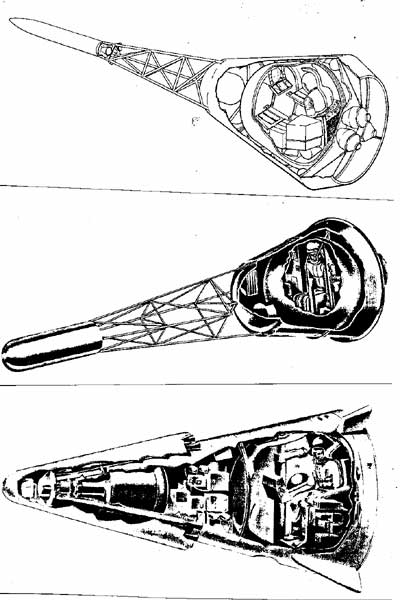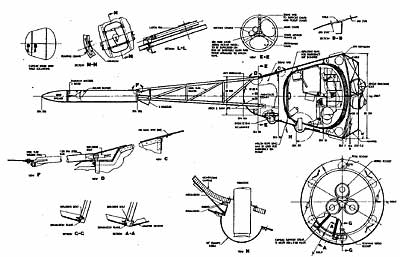Mercury rising: contractor proposals for the Mercury spacecraftby Dwayne A. Day
|
| The alternative Mercury designs provide a snapshot into the early spacecraft design process, at various competitors seeking an entry into the newly-created manned spacecraft field. |
The American civilian space program, to the extent that there was one, was primarily centered in the civilian National Advisory Committee on Aeronautics, or NACA, with most of the space research conducted at Langley Field in Virginia, on the mid-Atlantic coast. The NACA’s Space Task Group (STG) had been conducting research for the Air Force on a manned spacecraft to be launched atop a converted Atlas ICBM. NACA engineers had also developed their own interest in a manned space vehicle as a result of their long interest in advanced research aircraft like the X-15.
The Task Group, led by Max Faget and Caldwell Johnson, proposed a “blunt body” shape capsule to be launched ballistically atop an Atlas missile. This shape allowed the vehicle to reenter the earth’s atmosphere by creating a shock wave in front of the heat shield, keeping much of the high temperature air away from the spacecraft. By fall 1958, the Space Task Group had conducted numerous wind tunnel tests of scale models and revised its design. The designers faced several specific problems with the vehicle configuration, including heat shield temperature, heating of the forward body (or forebody) of the spacecraft, and how to fit the parachutes into the upper part of the vehicle. An earlier design, based upon sketches produced by Caldwell Johnson, consisted of a cone topped by a hemisphere with a cylinder on top. But after further modeling and testing, by late summer 1958 NACA designers changed this to a truncated cone-shape (known as a frustum) with a cylinder atop containing the parachute and other systems. They felt that this was the ideal shape for a manned spacecraft.
 From top to bottom: Douglas Aircraft’s 1958 Mercury spacecraft proposal; Avco’s illustration of its proposed Mercury spacecraft design featuring a spherical pressure capsule inside a rounded cone; and Martin’s proposal. All three designs violated NASA’s guidance in some way. The Avco design, for instance, was too wide at the base. Martin’s design featured a combined escape/retro-rocket package that fired along the side of the vehicle, a solution that was deliberately ruled out by the Space Task Group’s Max Faget. (credit: NASA via Dwayne A. Day) |
Congress passed legislation that President Eisenhower signed on October 1, 1958 formally creating NASA out of the NACA. The new space agency was given responsibility for the manned spacecraft program, which White House officials had determined should be a civilian and not a military effort. But the manned spacecraft program’s size and priority were not clearly established at this time and NASA officials had to determine how much effort would be devoted to it. Over the next weeks and months they developed a consensus that the manned spaceflight program would become NASA’s highest priority project. On October 23, the Langley procurement office mailed preliminary specifications for capsule and subsystems to more than 40 prospective companies. Thirty-eight of these companies sent representatives to a bidder’s conference at Langley Field on November 7.
In response to a question during the bidder’s conference, Max Faget explained that NASA expected contractors to use separate rockets for emergency escape and de-orbiting. The agency generally favored a “tractor” escape rocket design, with the rockets mounted above the spacecraft on a tower to pull it clear of the booster rocket. NASA had two other major requirements: the vehicle could not generate lift during reentry, and it had to use a heat-sink heatshield, which absorbed the heat of reentry, instead of an ablative heatshield, which shed the heat. Faget stated clearly that alternative spacecraft proposals would be considered “provided that you incorporate the retrorocket principle, the non-lifting principle, and the non-ablating heat sink principle.”
Nineteen companies expressed interest in bidding by mid-November and were sent copies of the STG’s 50-page “Specifications for Manned Space Capsule,” dated November 14, 1958. This document stated NASA’s technical requirements for the spacecraft, but did not indicate reliability, cost or schedule requirements. It included a line drawing of the latest—and heavily-tested—NASA spacecraft configuration, the frustum with the cylinder atop. The companies had until 11 December to send their formal bids to NASA.
By the December 11 deadline eleven companies had submitted bids. They represented virtually all major American aerospace companies: Avco, Convair/Astronautics, Lockheed, McDonnell, Martin, North American, Northrop, Republic, Douglas, Grumman, and Chance-Vought. Of these eleven firms, all except Douglas, Grumman and Chance-Vought had been conducting internal studies of manned spacecraft for at least a year and several had previously worked on Air Force studies of a manned spacecraft. Another company, Winzen Research, Inc., submitted a late, incomplete bid.
| By the December 11 deadline eleven companies had submitted bids. They represented virtually all major American aerospace companies. |
Over the next month, NASA evaluated the twelve proposals. Four were eliminated for technical reasons, although it is not clear from surviving records that four were disqualified. Because Winzen’s proposal was incomplete it was probably eliminated at an early stage. The remaining eight proposals then went to a Management, Cost, and Production Assessment Committee. This committee eliminated four more companies and recommended the remaining four to the Source Selection Board.
The seven-man Source Selection Board, headed by Abe Silverstein, narrowed the competition down to two finalists: McDonnell Aircraft Corporation, and more surprisingly, Grumman Aircraft Engineering Corporation, which had only been investigating manned spaceflight for a short time prior to bidding. The Source Selection Board apparently rated both companies’ bids essentially equally.
After reviewing both proposals, NASA Administrator T. Keith Glennan selected McDonnell because Grumman already had substantial Navy aircraft projects in the conceptual stage and would be short on manpower for the project, which had formally been named Mercury on December 17. On January 12, 1959 NASA informed McDonnell that it had been selected as primary contractor for the Mercury spacecraft.
